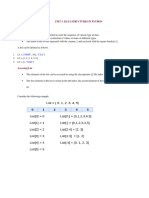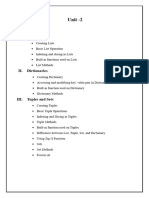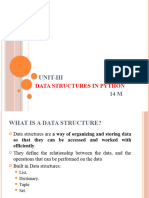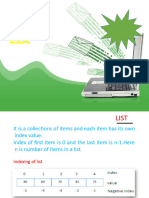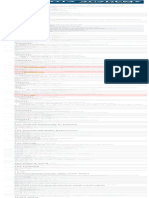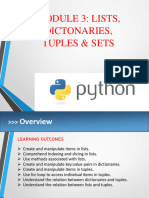0 ratings0% found this document useful (0 votes)
19 viewsPython Data Entry
The document shows examples of how to manipulate lists in Python. It demonstrates concatenating two lists using addition and the extend method. An empty list is created and elements are added using list literals. User input is taken to create a list by splitting on spaces and converting to integers. An element is searched for in the list and a message is printed depending on whether it is found.
Uploaded by
2147033Copyright
© © All Rights Reserved
Available Formats
Download as PDF, TXT or read online on Scribd
0 ratings0% found this document useful (0 votes)
19 viewsPython Data Entry
The document shows examples of how to manipulate lists in Python. It demonstrates concatenating two lists using addition and the extend method. An empty list is created and elements are added using list literals. User input is taken to create a list by splitting on spaces and converting to integers. An element is searched for in the list and a message is printed depending on whether it is found.
Uploaded by
2147033Copyright
© © All Rights Reserved
Available Formats
Download as PDF, TXT or read online on Scribd
You are on page 1/ 3
assignment 1
In [1]: # Define two Lists
listl = [1, 2, 3]
list2 = [4, 5, 6]
# Concatenate the Lists
concatenated list = listl + list2
# Display the concatenated List
print(concatenated_list)
[1, 2, 3, 4, 5, 6]
In [2]: # Define two Lists
listl = [1, 2, 3]
list2 = [4, 5, 6]
# Concatenate the Lists using extend()
listl.extend(list2)
# Display the concatenated List
print(listl)
[1, 2, 3, 4, 5, 6]
In [3]: # Create an empty List using the List constructor
my_list = list()
# Add elements to the List using List Literals
my_list += [1, 2, 3]
# Display the List
print(my_list)
[1, 2, 3]
In [4]: # Get a string from the user
user_input = input("Enter a list of numbers separated by spaces: ")
# Split the string into a List of substrings
my_list = user_input.split()
# Convert the substrings to integers
my_list = [int(i) for i in my_list]
# Display the List
print("The list is:", my_list)
# Get the element to search for from the user
search_element = int(input("Enter an element to search for: "))
# Check if the element is in the List
if search_element in my_list:
# If the element is in the List, display a message
print(search_element, "is in the list.")
else:
# If the element is not in the List, display a different message
print(search_element, "is not in the list.")
Enter a list of numbers separated by spaces: 94 93 99 97 96 96 98
The list is: [94, 93, 99, 97, 96, 96, 98]
Enter an element to search for: 96
96 is in the list.
1/3
You might also like
- 5.lists: 5.1. Accessing Values in Lists ExNo ratings yet5.lists: 5.1. Accessing Values in Lists Ex8 pages
- Srinivas Ram Cheat Sheet for Python TopicsNo ratings yetSrinivas Ram Cheat Sheet for Python Topics3 pages
- CSE 1001 (Python) Faculty Name: Dr. AMIT Kumar TyagiNo ratings yetCSE 1001 (Python) Faculty Name: Dr. AMIT Kumar Tyagi16 pages
- Learn Python 3_ Lists Cheatsheet _ CodecademyNo ratings yetLearn Python 3_ Lists Cheatsheet _ Codecademy5 pages
- Ai Unit1 (List, Tuple, Set, Dictionary) PDFNo ratings yetAi Unit1 (List, Tuple, Set, Dictionary) PDF15 pages
- Notes_Class_10_Recap_Python_List_Tuples_Dictionary_setNo ratings yetNotes_Class_10_Recap_Python_List_Tuples_Dictionary_set17 pages
- Learn Python 3_ Lists Cheatsheet _ CodecademyNo ratings yetLearn Python 3_ Lists Cheatsheet _ Codecademy5 pages



